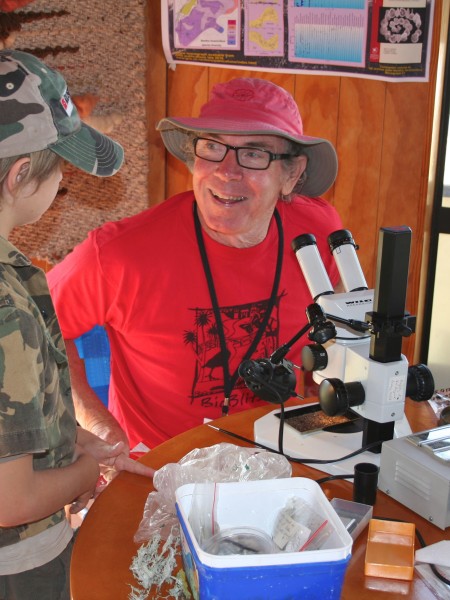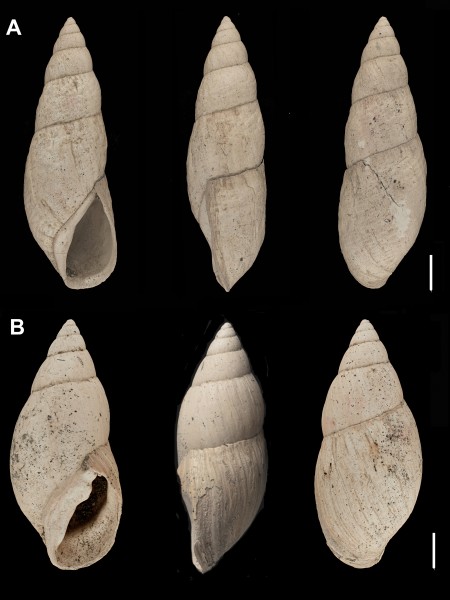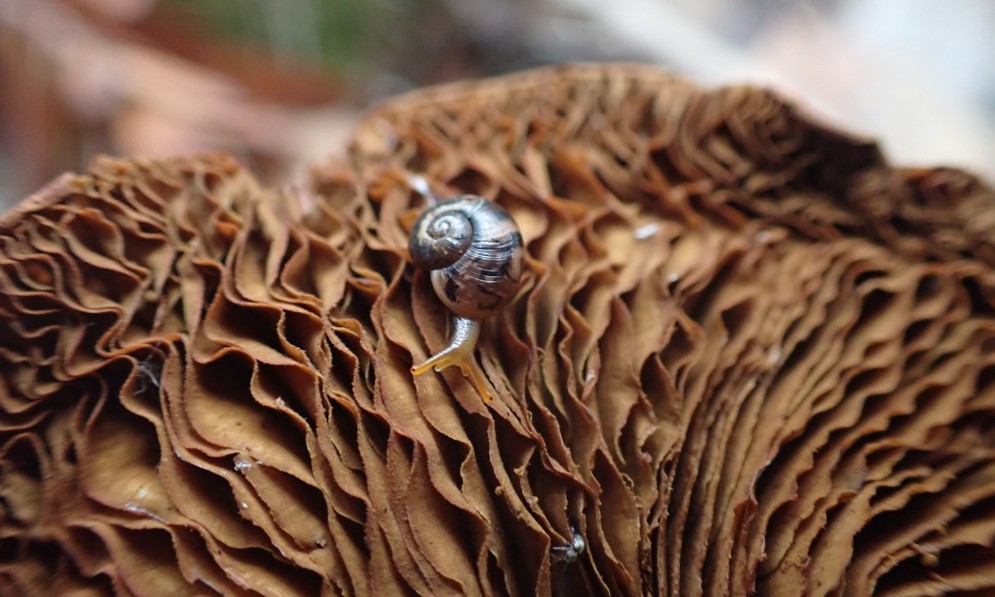Snails may not have the reputation of dinosaurs, but geologists knew there was something special about the fossils recently unearthed in Auckland. By Ursula Cochran
Forest & Bird magazine
A version of this story was first published in the Autumn 2024 issue of Forest & Bird magazine.
Discovered in a sandy layer buried deep beneath Tāmaki Makaurau Auckland, the fossil shells are tall dusty-white spirals about 7cm high. Their rounded whorls are scratched and pitted, signs that they’ve endured some history. But, to the average eye, it’s hard to see their significance. It turns out they are the oldest flax snail shells in the world, and it is a marvel they were found at all.
Their discovery began in an unlikely place: a construction site next to the Māngere Wastewater Treatment Plant. Here a tunnel-boring machine called Hiwa-i-te-rangi is excavating a tunnel almost 15km long and 4.5m wide under Auckland.
Part of Watercare’s Central Interceptor project, the tunnel will significantly reduce wet-weather overflows in central Auckland waterways. But before the tunnel boring could begin, a giant concrete shaft needed to be excavated to 40m underground.
Geologists knew from earlier boreholes that there was an interesting shell bed 35m below Māngere. Sure enough, after metres of excavation and with the shaft nearly complete, beautifully preserved fossil shells were unearthed.
Watercare could see that this was a rare opportunity to study otherwise inaccessible fossils. They contacted mana whenua and local specialists to see whether there was scientific interest – and there was.

Bruce Hayward.
Dr Bruce Hayward, of Geomarine Research, was particularly interested because he’d been working on outcrops of similar-aged sediment in which all the shells had dissolved away. He knew the discovery of such pristine fossils was significant.
Before long, New Zealand’s largest wastewater project was facilitating fossil hunting. A gigantic heap of sediment was stockpiled in a paddock in Māngere for more than a year so that fossils could be inspected more easily.
Watercare ran staff socials at the heap – get-togethers and BBQs – where staff, family, contractors, hapū members, students, and amateurs could dig for fossils at leisure.
There was much excitement over what was being found at these social digs, and collaboration ensued. Bruce was often heard to say, “That should go to the museum!” So Tāmaki Paenga Hira Auckland War Memorial Museum partnered with Watercare to document and archive many of the important specimens for educational use.
Tens of thousands of fossils were discovered in the heap. Most of them comprised a diverse range of temperate and subtropical seashells from an ancient shallow seafloor. There were also whale bones and, much to the delight of Shayne Cunis, Watercare’s project boss, a few sharks’ teeth.
But, of all these fossils, the ones that caught Bruce’s eye right from the start were not from the sea but from the land.
A single intact land snail shell was found by Stefano Vittor, of Ghella Abergeldie Joint Venture, in October 2020 – and another in December by Julianne McCoun, an Auckland University geology student.
Over several months, graduate students Nathan Collins and Thomas Stolberger sorted meticulously through the sediment pile and only found another nine intact land snail shells.
The stockpile of fossil-rich sediment from the shaft of Watercare’s Central Interceptor Project. Image Bruce Hayward
Bruce knew immediately they’d found flax snails – and likely the oldest ever found. He teamed up with independent researcher Fred Brook to identify the fossils. As described in their paper, they identified two new species of flax snail, including a completely new genus.
Welcome Maoristylus pliocenicus and Archaeostylus manukauensis – we never knew you existed and now we do.
There are only four living species of Maoristylus remaining – two in northern New Zealand and two on Lord Howe Island, Australia. The newly discovered fossil species Maoristylus pliocenicus differs from all of these but interestingly seems more closely related to one of the Lord Howe Island species than the New Zealand species.
Most of the fossils were ancient seashells. Image Bruce Hayward
Archaeostylus manukauensis is very different from all other flax snails and appears to be an endemic New Zealand lineage that has no living representatives.
The significance of discovering new species of flax snail is hard to estimate, especially ones that are now extinct. They wouldn’t have changed life on Earth dramatically, but they no doubt played a role.
Take pūpū harakeke, one of the flax snail species that is alive today. It is considered a kaitiaki by mana whenua of the Far North because it was said to warn locals of war parties by making a noise.
It is now understood that when frightened – for example, by approaching footsteps – the snails retreat into their shells en masse and the air escaping quickly from their shell chambers can make a flute-like whistling noise.
Hence their other name – pūpū whakarongotaua – the snail that listens for the war party. Is it not reasonable, then, to infer that land snails have saved human lives?

New Zealand’s new species of flax snail. A: Maoristylus pliocenicus and B: Archaeostylus manukauensis. The scale bar is one centimetre. Reproduced from Brook and Hayward, 2022, with the permission of the Royal Society of New Zealand.
The Māngere land snail fossils are not only new species, but they are by far the oldest flax snails in the world. Their record of life has been extended dramatically by these finds.
Previously, the oldest known flax snail fossils were a few hundred thousand years old. The Māngere fossils are about 3.5 million years old. They come from a time when there was no Manukau Harbour as we know it today, no Auckland volcanoes, and certainly no humans.
Back then an abundance of large flax snails browsed and sheltered in the coastal shrublands of northern Aotearoa. Instead of dying on the forest floor and having their shells dissolve in acidic soils like most other snails, these Māngere snails were buried in shelly sediment on the seafloor.
These days, divers around the Poor Knights Islands commonly see flax snail shells on the seafloor, sometimes inhabited by hermit crabs, presumably washed off the land in rainstorms.
Similarly, Bruce and Fred surmise that millions of years ago, the fossil flax snail shells were washed into a stream in heavy rain and carried out to a coastal inlet. Getting into the sea and being buried in shelly sediments was crucial to their survival as fossils.
For these shells to come to light, it took an ambitious tunnel-boring project, some expertise, curiosity, and hard work in the present, but also a bit of geological luck in the past. The newly proven antiquity of Aotearoa’s iconic flax snails is indeed worthy of celebration!
A rare find of an intact flax snail fossil. This is the new species Archaeostylus manukauensis. Image Julianne McCoun
“Taxonomy and taphonomy of Pliocene bulimoid land snails from Māngere, northern New Zealand, with descriptions of a new genus and two new species (Gastropoda: Bothriembryontidae: Placostylinae)”, Fred J. Brook & Bruce W. Hayward (2022), New Zealand Journal of Geology and Geophysics, 65:3, 491-506, DOI: 10.1080/00288306.2022.2072904

Pūpū rangi kauri snail on kauri cone. Image Ian Preece

Flax snail Maoristylus hongii. Image Shaun Lee/iNaturalist
Among snail enthusiasts, New Zealand is well known for its high diversity of land snails – we have more than 460 named species and perhaps more than 1000 altogether. The herbivorous Maoristylus (pūpū harakeke, flax snails) are now restricted to a few native shrubland and forest remnants in Northland and some offshore islands. Pūpū harakeke flax snails take their name from their source of shelter rather than their food, although they mainly live among fallen leaves. They are taonga for Māori and even part of Te Tiriti o Waitangi claims. Most land snails are tiny, with shells less than 1cm in diameter, but we also have some of the largest species in the world. These include carnivorous Paryphanta (pūpū rangi kauri snails) in Northland and Powelliphanta in the South Island and southern North Island.
Dr Ursula Cochran is a freelance science writer from Wellington. She was formerly an earthquake geologist at GNS Science.

